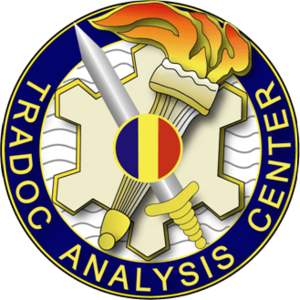United States Army Training and Doctrine Command Analysis Center facts for kids
The United States Army The Research and Analysis Center (TRAC) is a special group within the United States Army. TRAC studies how the Army might work in the future. They help leaders make smart choices about big challenges facing the Army and the Department of Defense (DoD). TRAC has many smart military and civilian people who work together to do this important job.
TRAC does something called operations research (OR). This means they study many military topics. Some topics are about today, but most are about 5 to 15 years from now. For example, they might ask:
- How should Army units be set up?
- What new equipment should the Army buy?
- How should soldiers and commanders be trained?
- What are the good and bad things about different choices?
- What are the possible risks and rewards of a military plan?
TRAC directly helps the Army's Training and Doctrine Command (TRADOC). TRADOC plans for the future and trains soldiers. TRAC also helps many other Army groups make important decisions.
Contents
TRAC's Main Goal
TRAC's main goal is to create useful and trustworthy studies. These studies help people make decisions. TRAC helps many different groups, but their most important focus is always on the American Soldier.
How TRAC is Organized
TRAC is led by a civilian director. This director reports to the head of the US Army Training and Doctrine Command. TRAC has four main centers:
- TRAC-Fort Leavenworth (TRAC-FLVN) is located at Fort Leavenworth, Kansas. It is in the same place as TRAC headquarters. This center usually studies how larger Army groups, like Corps and Divisions, work.
- TRAC-White Sands Missile Range (TRAC-WSMR) is in White Sands Missile Range in New Mexico. This center usually studies how smaller Army groups, like Brigades, work.
- TRAC-Lee is located at Fort Lee, VA. This center usually studies how the Army handles supplies and support (called Logistics).
- TRAC-Monterey is located at the Naval Postgraduate School (NPS) in Monterey, CA. This center uses the resources of NPS to research new ways of studying problems.
Each center director reports to the main TRAC director.
TRAC headquarters also has two parts:
- The director's staff: This includes the deputy director (a high-ranking colonel) and people who help with office tasks.
- The Program and Resources Directorate (PRD): This group works with the center directors. They manage the daily operations of all TRAC parts.
How TRAC Solves Problems
The way TRAC solves problems is called operations research. It involves different experts working together. They combine their knowledge and skills to study a problem. TRAC uses several building blocks to analyze military operations:
- Ideas about future situations.
- Advanced computer models and simulations.
- Real information about equipment, forces, and how people act.
- Skilled operations analysts.
A TRAC Study Director leads a team of analysts. They might also get help from other Army groups, government agencies, and even private companies. TRAC uses scientific methods to solve problems.
TRAC's Research Program
TRAC's research program looks ahead to the future. It covers many different military topics. Their studies look at how different Army groups work together in various missions and environments. TRAC leads TRADOC's main studies on new ways of fighting wars and how the Army should be organized.
TRAC also leads the Army's studies of Advanced Warfighting Experiments (AWEs). These are tests of new ideas. They also lead the Army's Analysis of Alternatives (AoA). This means they compare different choices for the Army. The topics they study include:
- Army rules and guidelines (doctrine).
- Training methods.
- How leaders develop.
- How the Army is organized.
- Equipment (materiel).
- Support for soldiers.
Planning for the Future
The U.S. Army uses "scenarios" for training and planning. Scenarios are like stories about possible future events. The Director of TRAC is in charge of creating these scenarios for studies and analysis. TRAC develops scenarios about future military operations. They use these for computer modeling and analysis.
TRAC gets help from many Army and DoD groups, other military branches, and commanders. They create a set of scenarios that show how different Army groups might work together. These scenarios are always being reviewed and changed. This helps them prepare for new threats and different situations around the world. They base these changes on intelligence information.
Tools TRAC Uses
Military operations are very complex. TRAC often uses models to study them. These tools can be:
- Table-top map games: Like playing a board game to plan military moves.
- Human-in-the-loop (HITL) simulations: Where real people make decisions as part of a computer simulation.
- Closed-form Models & Simulations (M&S): Computer programs that run by themselves to show what might happen.
- Controlled field experiments: Testing things out in real-world settings.
TRAC creates and uses special computer models called "force-on-force" M&S. These models show how different military forces interact. They can model individual soldiers or large groups like battalions. TRAC's models are widely used by the military, companies, and allies. TRAC also helps develop new and better ways to use models in the military.


